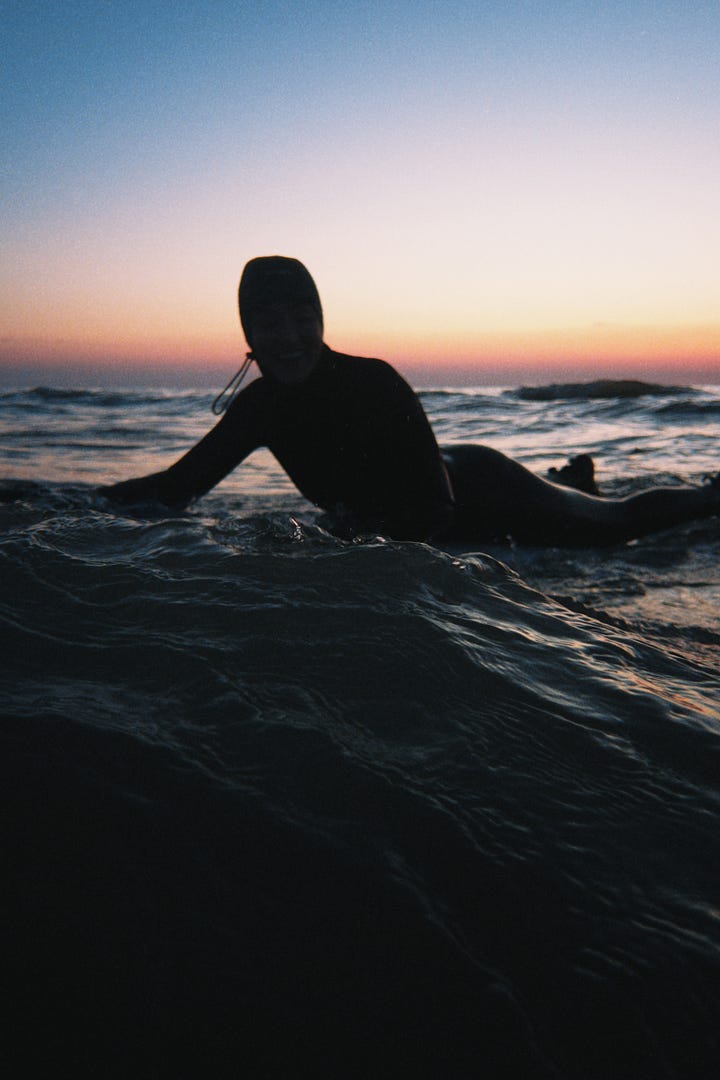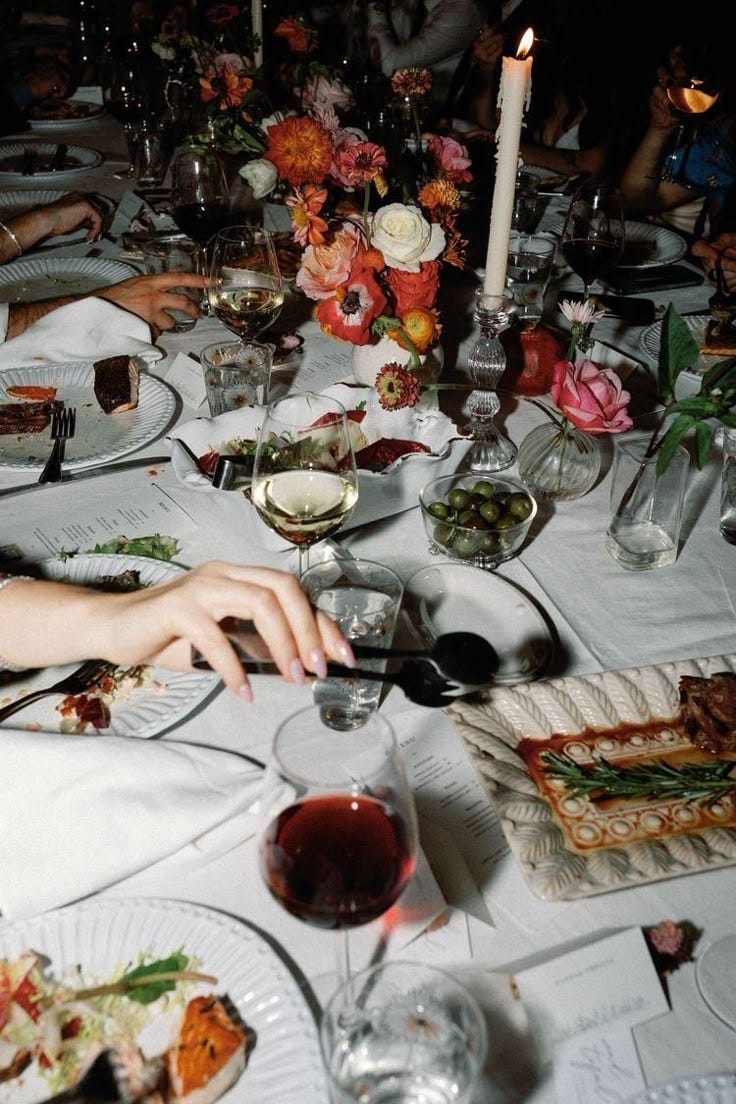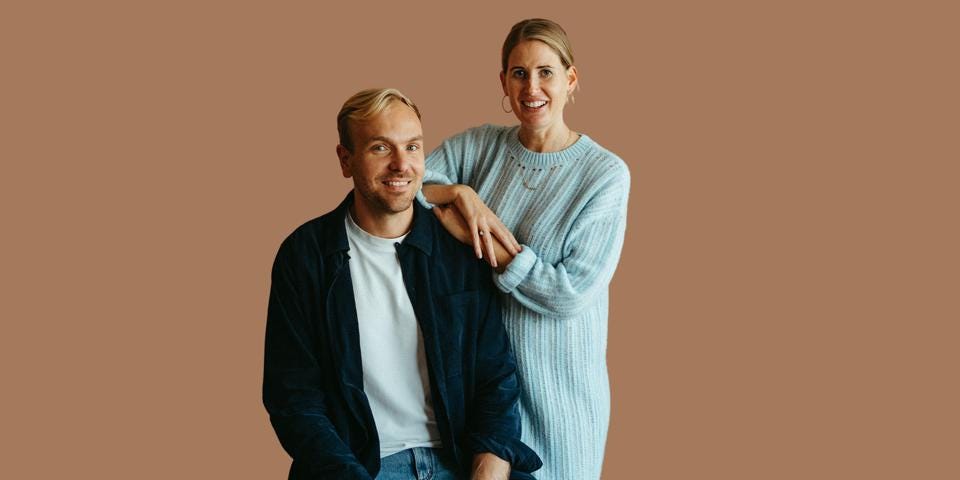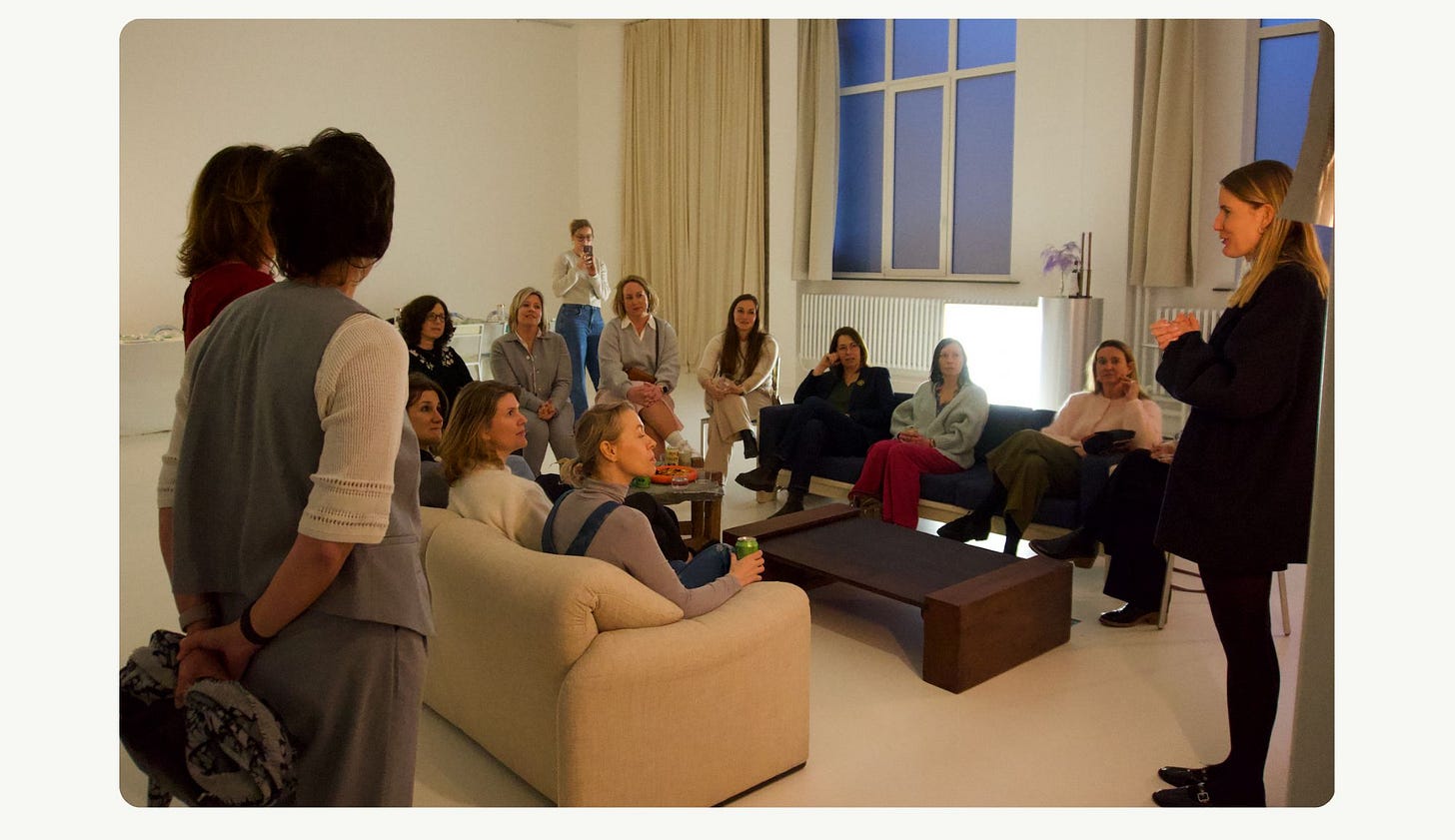Guud Gets It. $2.6B Gets Wired Into Femtech. IRL Gets Real.
The algorithm won't save us, but maybe a dinner party will.
Founder Journey: Link in Bio, But Make It Human
I used to think I was elite at being alone. Inner-peace-on-a-plane-seat kind of good. Then I caught myself trying to force group chats into meaning. Weekly club meets no one showed up to. “No big deal,” I said. Translation…I will remember this forever.
Some things did stick (read here). But mostly, I realized being good at solitude doesn’t mean you're not craving connection.
That hit me while surfing the Great Lakes with my best friend (Apologies for the posting delay. I was enjoying my hiatus). Two degrees Celsius. She’s Canadian, so immune to cold. I was just pretending not to die.
But between the waves and post-surf veggies, something settled. Maybe I wasn’t missing solitude. Maybe I was missing people I didn’t have to perform around.
So, how do we build that—real connection—in a world where intimacy feels like a luxury product and loneliness is an epidemic?
How do we build anything that lasts when everything’s optimized for scrolling, not staying?
We’ll get into it in this newsletter. Gen Z. Femtech. IRL (In-Real-Life) things.
Bring snacks.


Gen Z DeCode: Why intimacy, hosting, and curated offline spaces are becoming a wellness flex.
Words like “community,” “self-care,” and even “dinner” don’t mean what they used to. For Gen Z, they’ve become coded language for status, identity, and emotional survival. The latest form of luxury isn’t a product but rather being invited to the right table. Literally.
We’re in a cultural pivot from optimization to presence, from scrolling to savoring. Dinner parties, slow hosting, and IRL intimacy are back, but not in the way our parents did them. They’re curated, micro, and deeply intentional. Think seed-cycling mezze nights, hormone-balancing potlucks, period-story powerpoint nights. Yes, really.
The rise of Gen Z dinner parties is driven by a craving for emotional connection and creative control in a world that feels increasingly performative and isolating. Hosting is the vibe. A personality trait. A soft power play. It’s also medicine. The Family Dinner Project highlights how shared meals reduce loneliness and improve emotional well-being, the two things Gen Z is quietly starving for.
But make no mistake, this isn’t only about connection. There is a hint of cultural capital in the mix. In the same way wellness products became status symbols, hosting has become a kind of analog clout. The same way you’d flex a $300 Oura Ring, now you flex the fact that your dinner guest list includes a reproductive health doula, an ex-cult escapee, and someone who started a seed fund for menstruation equity.
And for femtech brands? This is a signal to stop chasing virality and start building vibe economies. Hosting is the new brand experience. It’s intimate. It’s high-retention. And it works. A friend of mine has been doing an exceptional job hosting (see example).
So, how would I execute IRL community engagement and brand?
GUUD: A Sample Case
I will be using Guud—a Belgium-based natural supplements company designed for women's hormonal journey— as an example since they are my featured guest in today’s newsletter.
Here’s how I’d approach it:
Campaigns that double as cultural commentary:
Community building as micro-curation: small cohort chats, in-person salons, and analog intimacy as brand equity.
More curated dinners: Time of the Month- A hormone-friendly menu co-designed with a nutritionist, hosted in a candlelit dinner series across European cities.
Subject Matter Expert Archtype Collaborations + Microinfluencers:
Educator: e.g. A pharmacist or dietitian TikToker with loyal Gen Z fans
Relatable Confessor: e.g. A 30-something with PCOS sharing her real hormonal journey
Underrated Healer: e.g. A doula or herbalist who blends science + tradition
Kitchen Creator: e.g. A chef who meal preps for their cycle and posts no-filter IG Stories
Research-Backed Rebel: e.g. Someone who calls out pharma/wellness BS but gives tips too
Collaborations wouldn’t be just to post UGC but to build loops:
Invite them to co-host a dinner or Zoom (record content from it)
Feature them in “Guud Voices” content (short-form or blog-style)
Let them test a product before launch, and film their honest takes
Use their insights to shape future content themes (give credit in a community email!)
Content strategy that blends narrative and niche
Every Guud product drop, announcement, or partnership should live inside a story. Whether it’s tied to a health trend (e.g., the rise in hormone testing), a cultural moment (e.g., the “symptom girls” TikTok wave), or framed through the voice of a niche creator (e.g., a PCOS coach, hormone nutritionist, or Gen Z health essayist), the update should feel like content, not corporate.
PR ≠ press release. PR = plot development.
Use Jan and Morgane as recurring characters in a filmed, founder-led series:
“Building Guud” — a casual, voyeuristic docuseries capturing behind-the-scenes moments (product R&D, community dinners, feedback calls)
Morgane as a health protagonist navigating real hormonal challenges—“The Founder Is Also the User”
Founder POV used as a billboard: filmed walks, voice notes, reaction videos to hormone myths, etc.
Think: the intimacy of Alexis Bittar, but make it grounded and cyclical.
Guud in the Hood: A punchy social video series asking women on the street IRL simple questions like:
What does PCOS stand for? Quiz women on their basic knowledge of PCOS (which, if I were to guess, would be pretty low). The results will be shocking.
The goal: awareness through surprise. Education through humor.
Follow-up content = tips, myths, and solutions (featuring Guud's actual products + experts).
Wellness doesn’t live in coaching and dashboards alone anymore.
Femtech brands that win will be the ones who understand this offline cultural shift and build into it.
In a world where your algorithmic value is dictated by your engagement rate, the real rebellion is showing up in person and being deeply, wildly present.
IRL and dinners are the new medicine. And perhaps a new form of marketing.
I’m thinking of throwing one in NYC in collaboration with a brand! If you or your brand is interested, respond to this email!
THE FUTURE of FEMTECH:
If 2024 was about proving femtech could scale, 2025 is about watching the category mature in real time. Women’s health startups raised $2.6B last year—a 55% jump from 2023, marking a five-year increase of over 300% in funding. The early DTC fertility app era has given way to broader plays in menopause care, maternal health, and hormonal therapies, with institutional investors finally waking up to what founders have been saying for years: women’s health is a massive, undercapitalized market. Business models are evolving fast—Kindbody’s full-stack model is setting the bar for vertical integration, while others are blending supplements, telehealth, and clinic partnerships into seamless DTC/IRL hybrids. And AI is no longer a novelty but the expected infrastructure, powering personalized care plans and symptom mapping at scale. Those invested should be looking for brands that can build not just audiences, but ecosystems.
At the consumer layer, Gen Z has its own playbook. They’re 63% more willing to talk openly about periods than older generations and treat hormone health the same way they treat skincare: proactive, optimized, and personalized. They want brands that understand that mental health is hormonal health, and they’re willing to pay for it. More than 70% of Gen Z say they’ll spend more on period wellness if it’s sustainable and inclusive, and 50% prioritize clinical credibility over pure aesthetic. They’re also doing their homework—over 60% of Gen Z users at one wellness brand said they found it through personal research into preventative hormone care, not a diagnosis or ad campaign. Brands that win in this space won’t just be “science-backed”—they’ll be smart about how that science is communicated, community-powered, and deeply fluent in the vibes economy.
Curation:
Estrogen and progesterone trigger natural pain relief in women (UCSF)
Tech-assisted peer therapy eases perinatal depression in low-income settings (University of Liverpool)
Trump admin freezes $66M in Title X funding, jeopardizing women’s clinics (Guardian)
Gen Z women turn to TikTok and Reddit for endo diagnoses (AdelaideNow)
Mental health drives Gen Z gym sign-ups as much as fitness goals (Guardian)
CDC cuts team that tracked IVF and reproductive health due to HHS layoffs (Healthcare Brew)
Ireland delays free menopause treatment rollout to June (The Sun)
UN launches global challenge to fund women’s health innovations (UNFPA)
Deal Sheet and Fundraising:
Meghan Markle joins $63M round in menopause startup Midi Health, backed by OpenAI, Meta, and Hollywood power players (YahooFinance)
Wingwomen secures $2M to develop AI-powered vaginal speculum (MedTech World)
Arva Health raises $1M to launch tech-enabled fertility clinics in India (Entrepreneur)
Fizimed raises €4M to expand pelvic health tech internationally (Femtech Insider)
Calla Lily secures £1M to trial progesterone delivery device for miscarriage prevention (Med-Tech Insights)
Rhea Fertility acquires Tilly to integrate mental health support in fertility care (GenPrime)
The Cycle: Maybe all we need is just Guud company!
I spoke with Jan Deruyck, CEO and cofounder of Guud (alongside his wife Morgane), about building a brand that grew from a hormone health community into a consumer product company with roughly $2.2 mill in funding. We unpack how Guud reversed the usual DTC model, leading with belonging before supplements, and why curated offline moments like perimenopause dinners are becoming the new frontier for intimacy, influence, and insight. This one’s for anyone thinking about how community scales (or doesn’t) and what it means to be a real brand in an AI/technology-shaped world.
Nilah: Can you tell me a little bit about Guud and what you guys are doing?
Jan: Yeah, a hundred percent. So, Guud started as a community. We help women who experience hormonal imbalances, whether it's PMS or perimenopause, by giving them knowledge, support, and eventually, supplements that work.
What started as just a community quickly grew into an integrated platform. On one side, we had services like content, expert advice, and a supportive Facebook group. On the other hand, we added products because my partner and cofounder, Morgane, kept seeing how bad a lot of over-the-counter stuff was. That frustration pushed us to create something better.
Nilah: Was your community mostly online at first?
Jan: We started during COVID, so it was all virtual at the beginning— live events, podcasts, expert panels. But as soon as we could, we began doing hybrid: online support combined with offline events like dinners, live podcast recordings, and anniversary celebrations. We found that in-person moments brought the community closer. 2024 was mostly commercial and digital for us, but we realized we missed the real-life connection. So this year, we’re prioritizing it again, like our recent perimenopause dinner.
Nilah: What are the key elements of your hybrid model? What makes it work?
Jan: We realized early that people going through hormonal changes often feel alone. My wife went through that. And it was isolating. But once she found community, both online and offline, she could start to move forward. So that's one piece: belonging.
The other is intimacy. Not everyone wants to speak up in a massive 40,000-person Facebook group. So we’re testing small-group cohorts of about four to six people, instead of huge communities. Same thing offline. We’re creating these intimate experiences that feel personal, safe, and validating.
Nilah: And did you notice anything at the live events that surprised you, compared to digital?
Jan: Definitely. First, even for our team: designers, social folks—it was huge. They rarely meet users face-to-face. After the dinner, our designer said it was one of her favorite work moments.
Second, the language people use in person is different. You start hearing real patterns, feedback, and emotional expressions that are harder to capture in surveys. It gives us better insights for product, copy, and messaging.
Nilah: How do these live experiences fit into your broader brand and marketing strategy?
Jan: In this age of AI and automation, people want to connect with real humans. These events are like long-form content in real life. They reveal our values, show our team, and let people experience our brand viscerally.
We always bring those moments back into our online world, posting content, sharing testimonials, even snippets from group chats in our emails. It builds trust and extends the story.
Nilah: A lot of Gen Z founders and marketers are leaning into intimate, brand-sponsored dinners to create community. Did you approach your events with content or UGC (user-generated content) in mind?
Jan: Yeah. Our audience is Gen Z, and our team is too. We regularly host events for micro- and nano-influencers. We don’t pay for sponsorships, and everyone we work with genuinely believes in the mission. Some have even helped with product development.
We’ve hosted dinners, and we’re bringing folks to a curated event in Paris this year. It’s a smart strategy. Create moments adjacent to bigger conferences where the vibe is overly corporate. People are already in town, and you can curate the narrative.
Nilah: So if a smaller startup founder wanted to replicate this, what’s your advice?
Jan: Start small. Look for people whose lifestyle is about 12 months ahead of your customer. Build authentic relationships. Reach out, offer free product, get feedback, but not in a transactional way. Make it real.
Then meet in person. Host a small dinner or roundtable. Ask for input. It builds community and gives you product insight at the same time.
Nilah: Should startups focus on community early, or wait until they scale?
Jan: I’m biased, but build it early. Community won’t get you to $100 million, but it will get you your first 100 customers. We didn’t spend on acquisition because we already had trust from our community.
We tracked everything: content produced, lives hosted, engagement metrics and once it hit a tipping point, the flywheel took off. That base community of testers and advocates made all the difference.
Nilah: Do you use events for product development too?
Jan: All the time. It’s four birds with one stone: content, testimonials, influencer relationships, and product feedback. Bring new flavors, test packaging, and get real-time reactions.
There’s a great UK brand, Tallow + Ash, who do this constantly. They involve their community in voting, flavor picks, and even share when things flop. That transparency builds serious loyalty.
Nilah: What’s next for Guud’s community?
Jan: We’re moving our online group to a more proprietary platform and launching both online and offline events again. We’re testing live podcast recordings, small cohort events, and new product experiences.
We underinvested in community last year. This year, we’re correcting that. Listening more. Creating more touchpoints. And making the kind of experiences people remember.
Nilah: Amazing. And where can people connect with you or learn more about Guud?
Jan: LinkedIn’s the best place to find me personally. I also write on Substack about profitable brand growth. And for the company, our site is guudwoman.com.









This is such a great read Nilah! 🔥I didn’t know Guud was doing so much in the real world space but everything you’ve written about here aligns so well with what they stand for